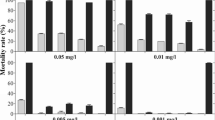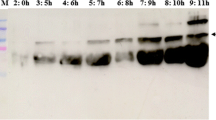Abstract
Crystals of a local isolate of Bacillus thuringiensis variety israelensis were isolated by centrifugation on a continuous sucrose gradient (40–70%). Analysis of the crystals by SDS-PAGE revealed three major protein subunits of Mr~25,000, ~66,000 and Mr~140,000. The crystals were solubilised using high pH and reducing conditions. Analysis of the soluble (protoxin) and insoluble fractions by SDS-PAGE showed the presence of proteins of Mr~21,000 and ~61,000, respectively. Proteolytic treatment of these fractions resulted in no apparent change in the molecular weights of the proteins. The crystals contained carbohydrate moieties as determined by periodic acid Schiff (PAS) and fluorescein isothiocyanate (FITC) Concanavalin A staining. In double radial immunodiffusion experiments, antisera raised against the Mr~21,000 and ~66,000 subunits did not react with other B. thuringiensis protoxins known to be active against the tsetse fly, Glossina morsitans morsitans, and the stemborer, Chile partellus.
Résumé
Les cristaux d’un isolat local de Bacillus thuringiensis var. israelensis ont été isolés sur un gradient de saccharose continu (40–70%). L’analyse des crystaux par SDS-PAGE a mis en évidence trois sous-unités protéiques majeures de Mr ~25.000, ~66.000 et Mr ~140.000. Les crystaux ont été solubilisés en utilisant un pH élevé en conditions réductrices. L’analyse des fractions solubles (protoxines) et insolubles par SDS-PAGE a montré la présence des protéines de Mr ~21.000 et ~61.000. respectivement. Le traitement protéolytique de ces fractions a eu comme résultat un changement non apparent dans les poids moléculaires des protéines. Les cristaux contenaient des moüetés d’hydrates de carbone telles que determinées par l’acide périodique de Schiff (PAS) et l’isothiocianate de flourecéine (FTTC) qui colore la canavaline A. Dans les expériences de double immunodiffusion radiale, les antisérums produits contre les sous-unités Mr ~21.000 et ~66.000 n’ont pas réagi avec les autres protoxines de B. thuringiensis qui sont reconnues comme actives contre la mouche tsé-tsé, Glossina morsitans morsitans, et la foreur de tiges, Chilo partellus.
Similar content being viewed by others
References
Abdel-Hameed A., Lounatmaa K., Carlberg G. and El Tayeb O. M. (1990) Studies on Bacillus thuringiensis H-14 strains isolated in Egypt—II. Ultrastructure studies. World J. Microbiol Biotechnol. 6, 305–312.
Brownbridge M. (1989) Isolation of new entomopathogenic strains of Bacillus thuringiensis and Bacillus sphericus. Isr. J. Entomol. 23, 109–113.
Bulla L. A. Jr., Kramer K. J. and Davidson L. I. (1977) Characterization of the entomocidal parasporal crystal of Bacillus thuringiensis. J. Bacteriol. 130, 375–383.
Burges H. D. (1982) Control of insect pests by bacteria. Parasitology 84, 79–117.
Carroll J., Li J. and Ellar D. J. (1989) Proteolytic processing of a coleopteran-specific δ-endotoxin produced by Bacillus thuringiensis var. tenebrionis. Biochem. J. 261, 99–105.
Drobniewski F. A. and Ellar D. J. (1989) Purification and properties of a 28-kilodalton haemolytic and mosquitocidal protein of Bacillus thuringiensis subsp. darmstadiensis 73-E10-2. J. Bacteriol. 171, 3060–3076.
Dulmage H. T. (1975) Standardization and formulations of the delta-endotoxin produced by Bacillus thuringiensis. J. Invertebr. Pathol. 25, 279–281.
Fast P. G. (1981) The crystal toxin of Bacillus thuringiensis, pp. 223–248. In Microbial Control of Pests and Plant Diseases 1970–1980 (Edited by H. D. Burges). Academic Press Inc., New York.
Furlan M., Perret B. A. and Beck E. A. (1979) Staining of glycoproteins in Polyacrylamide and agarose gels with fluorescent lectins. Anal. Biochem. 96, 208–214.
Gill S.S., Cowles A. E. and Pietrantonio P. V. (1992) The mode of action of Bacillus thuringiensis endotoxins. Annu. Rev. Entomol. 37, 615–636.
Goldberg L. H. and Margalit J. (1977) A bacterial spore demonstrating rapid larvicidal activity against Anopheles sergentii, Uranotaenia unguiculata, Culex univittatus, Aedes aegypti and Culex pipiens. Mosq. News 37, 355–358.
Haider M. Z., Knowles B. H. and Ellar D. J. (1986) Specificity of Bacillus thuringiensis var. colmeri insecticidal delta-endotoxin is determined by differential proteolytic processing of the protoxin by the larval gut proteases. Eur. J. Biochem. 156, 531–540.
Höfte H. and Whiteley H. R. (1989) Insecticidal crystal proteins of Bacillus thuringiensis. Microbiol. Rev. 53, 242–255.
Ibarra J. E. and Federici B. A. (1986) Isolation of a relatively non-toxic 65-Kilodalton protein inclusion from the parasporal body of Bacillus thuringiensis subsp. israelensis. J. Bacteriol. 165, 527–533.
Kapitany R. A. and Zebrowski E. J. (1973) A high resolution PAS stain for Polyacrylamide gel. Anal Biochem. 56, 361–369.
Knowles B. H., Francis P. H. and Ellar D. J. (1986) Structurally related Bacillus thuringiensis delta-endotoxin display major differences in insecticidal activity in vivo and in vitro. J. Cell Sci. 84, 221–236.
Knowles B. H., White P. J., Nicholls C. N. and Ellar D. J. (1992) A broad spectrum cytolytic toxin from Bacillus thuringiensis var. kyushuensis. Proc. R. Soc. Lond. 248, 1–7.
Kreig A., Huger A. M., Langenbruch G. A. and Schnetter W. (1983) Bacillus thuringinsis var. tenebrionis, ein neuer gegenuber larven von coleopteran wirksamer Pathotyp. Z. angew Ent. 96, 500–508.
Laemmli U. K. (1970) Cleavage of structural proteins during the assembly of the heads of bacteriophages T4. Nature London 227, 680–683.
Mikkola A. R., Goldberg G. A., Vaara T. and Gyllenberg H. G. (1982) Comparison of inclusions in different Bacillus thuringiensis strains. An electron microscopy study. FEMS Microbiol Lett. 13, 401–408.
Muthukumar G. and Nickerson K. W. (1987) The glycoprotein toxin of Bacillus thuringiensis subsp. israelensis indicates a lectin-like receptor in the larval mosquito gut. Appl. Environ. Microbiol. 53, 2650–2655.
Osir E. O., Wells M. A. and Law J. H. (1986) Studies on vitellogenin from the tobacco hornworm, Manduca sexta. Arch. Insect Biochem. Physiol. 3, 217–225.
Ouchterlony O. (1958) Diffusion-in-gel methods for immunological analysis, pp. 1–78. In Progress in Allergy Vol. 5 (Edited by P. Kallos). Karger, Bassel.
Pfannenstiel M. A., Couche G. A., Ross E. J. and Nickerson K. W. (1986) Immunological relationships among proteins making up the Bacillus thuringiensis subsp. israelensis crystalline toxin. Appl. Environ. Microbiol. 52, 644–649.
Pfannenstiel M. A., Muthukumar G., Couche G. A. and Nickerson K. W. (1987) Amino sugars in the glycoprotein toxin from Bacillus thuringiensis subspecies israelensis. J. Bacteriol 169, 796–801.
Pfannenstiel M. A., Ross E. J., Kramer V. C. and Nickerson K. W. (1984) Toxicity and composition of protease inhibited Bacillus thuringiensis variety israelensis crystals. FEMS Microbiol. Lett. 21, 39–42.
Smirnoff W. A. (1962) A staining method for differentiating spores, crystals and cells of Bacillus thuringiensis (Berliner). J. Invertebr. Pathol. 4, 384–386.
Thomas W. E. and Ellar D. J. (1983) Bacillus thuringiensis var. israelensis crystal δ-endotoxin: Effects on insect and mammalian cells in vitro and in vivo. J. Cell Sci. 60, 181–197.
Tyrell D. J., Bulla L. A., Jr., Andrews R. E., Jr., Kramer K. J., Davidson L. J. and Nordin P. (1981) Comparative biochemistry of entomocidal parasporal crystals of selected Bacillus thuringiensis strains. J. Bacteriol. 145, 1052–1062.
Yu Y. M., Ohba M. and Gill S. S. (1991) Characterization of mosquitocidal activity of Bacillus thuringiensis subspecies fukuokaensis crystal proteins. Appl. Environ. Microbiol. 57, 1075–1081.
Author information
Authors and Affiliations
Additional information
See Editor’s Note at the end of this issue.
Rights and permissions
About this article
Cite this article
Wamunyokoli, F.W., Osir, E.O. Characterisation of Bacillus thuringiensis Variety Israelensis Delta-Endotoxin. Int J Trop Insect Sci 16, 343–349 (1995). https://doi.org/10.1017/S1742758400017380
Accepted:
Published:
Issue Date:
DOI: https://doi.org/10.1017/S1742758400017380




